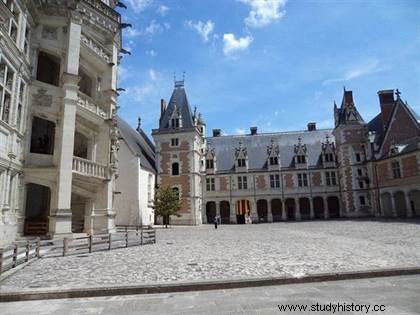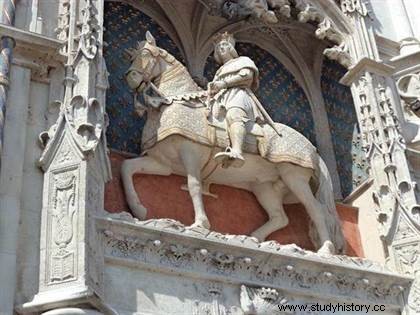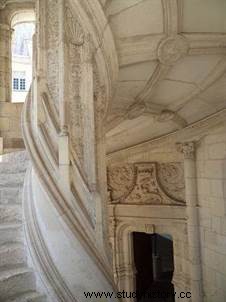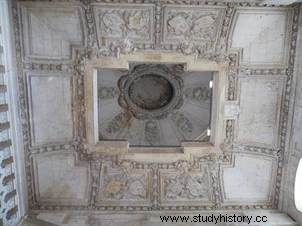 Among the Loire castles , Blois is probably one of the most original. Indeed, his singular story allows us to discover three distinct architectural styles:Flamboyant Gothic, Renaissance and Classical. The castle is also famous for its remarkable Grand Staircase, built in the middle of the François I wing during the reign of the latter. Residence of the Counts of Blois, then of the Kings of France from Louis XII to Henri III, the scene of decisive events such as the assassination of the Duke of Guise, it is a remarkable monument for approaching the history of France during troubled times. like the wars of religion.
Among the Loire castles , Blois is probably one of the most original. Indeed, his singular story allows us to discover three distinct architectural styles:Flamboyant Gothic, Renaissance and Classical. The castle is also famous for its remarkable Grand Staircase, built in the middle of the François I wing during the reign of the latter. Residence of the Counts of Blois, then of the Kings of France from Louis XII to Henri III, the scene of decisive events such as the assassination of the Duke of Guise, it is a remarkable monument for approaching the history of France during troubled times. like the wars of religion.
The Counts of Blois in the Middle Ages
Placed on a strategic position, at the top of a hill overlooking the Loire, Blois has been a place of power since the counts of Blois, from the Carolingian era. The influence of these counts, initially designated by Charlemagne to control territories, increased from the 11th century, when their possessions grew with the acquisition of Touraine and the Chartrain country, then the county of Champagne, thus encompassing the small royal domain, and opposing the powerful Anjou.
However, nothing remains today of their constructions, except the great hall of the States, built at the beginning of the 13th century, during the reign of Philippe Auguste.
At the same time, the line died out and the county of Blois passed to the house of Châtillon-sur-Seine until the end of the 14th century, when the house was built the enclosure, of which some remains remain today (including the tower of Foix). It was then bought by Louis d'Orléans, brother of the King of France Charles VI. In 1407, the Duke of Orléans was assassinated on the orders of Jean sans Peur, and his widow, Valentine Visconti, died in Blois a year later. He was succeeded by his son, Charles, who was captured at the battle of Agincourt (1415) and imprisoned in England until 1440. It was there that he began to compose his nostalgic poems, becoming the "duke-poet". Back in Blois, he developed the arts at his court, inviting and protecting poets like François Villon (1431-1463?), organizing poetry competitions.
During the captivity of Charles d'Orléans, in 1429, Joan of Arc passed through Blois and had her standard blessed there, before going to liberate Orléans from the English siege.
The castle of Blois during the Renaissance
On the death of the Duke of Orléans in 1465, his son Louis II succeeded him. This one becomes king of France in 1498, following the accidental death of Charles VIII, his cousin, in Amboise. Louis XII then married the widow of Charles VIII, Anne of Brittany, as provided for in her marriage contract with the deceased king.

The King of France, born in Blois in 1462, obviously keeps a strong link with the castle. He therefore undertook renovation work, and built the brick and stone wing, known as the Louis XII wing (through which visitors today enter the castle), as well as the gallery, the chapel, and another wing which has since disappeared, as have the gardens. The work took place between 1498 and 1501, and Louis XII was thus able to welcome Philippe le Beau and Jeanne la Folle, parents of Charles V, during their stay in France. A few years later, it was Machiavelli who resided in Blois, as ambassador of Florence.
In 1515, François I succeeded his cousin Louis XII, while Anne of Brittany died in Blois the previous year. Inspired by the Italian style, the new King of France continued the work of his predecessor, renovating another wing, while keeping the walls of the medieval castle. The Grand Staircase was built against this François I wing. The style of the two facades (that of the main courtyard, and that known as the Lodges) shows the evolution of architectural taste over barely fifteen years, from the Middle Ages (the Louis XII wing) to the Renaissance. (the François I wing). A style that mixes French and Italian taste.
During the beginning of the reign of François I, Blois was one of the favorite royal residences, but the situation changed after the defeat of Pavia (1525) and the detention of the king. On his return, he decided to move closer to Paris, and transferred the furnishings of the Loire castles (including Blois) to Fontainebleau in 1539. The same year, François I nonetheless welcomed Charles Quint to the Château de Blois.The place remains an important place for the kingdom and the arts, even after the departure of François I, as shown by the famous example of Pierre Ronsard (1524-1585), who would have met his muse Cassandre during a ball at the Court of Blois, in 1545.
In the tumult of religious wars
When Francis I died, his son Henry II ascended the throne. Like his father, he spent less time in Blois (the county was integrated into the royal domain), but the artistic life was still active there, even more so when the Court was passing through, thanks to the influence of Catherine de Medici.
 She still grew in importance on the death of her husband (1559) and following the premature death of Francis II. The second son of the royal couple, Charles IX, becomes king when the wars of religion break out. In 1562, the Catholics took Blois, where Protestants were hanged on the orders of Anne de Montmorency. Under the impetus of the Queen Mother, the Treaty of Amboise was signed in 1563, and Admiral de Coligny welcomed to Blois by Catherine de Medici. Thus, until Saint Barthélémy (1572), the Château de Blois remained a place of meetings and negotiations during the civil war, and Charles IX stayed there regularly. It was also in Blois that the marriage between Henri de Navarre and Marguerite de Valois was negotiated.
She still grew in importance on the death of her husband (1559) and following the premature death of Francis II. The second son of the royal couple, Charles IX, becomes king when the wars of religion break out. In 1562, the Catholics took Blois, where Protestants were hanged on the orders of Anne de Montmorency. Under the impetus of the Queen Mother, the Treaty of Amboise was signed in 1563, and Admiral de Coligny welcomed to Blois by Catherine de Medici. Thus, until Saint Barthélémy (1572), the Château de Blois remained a place of meetings and negotiations during the civil war, and Charles IX stayed there regularly. It was also in Blois that the marriage between Henri de Navarre and Marguerite de Valois was negotiated.
Henry III, who acceded to the throne in 1574, stayed in Blois more often than his predecessors. Above all, it was in the castle itself, in his own bedroom, that the king had his rival and leader of the League, the Duke of Guise, assassinated in 1588. A year later, he was also killed, and Henri de Navarre becomes king under the name of Henri IV. The same year, Catherine de Medici died in Blois.
Blois in the Grand Siècle
With the end of the Valois came the end of the Château de Blois as a royal residence, especially after Henry IV, who stayed there for a short time in the middle of his reign. Blois then becomes a kind of residence for the rivals or enemies of the king. Thus, Louis XIII had his mother, Marie de Médicis, watched there in 1617. Two years later, she escaped and was eventually exiled to Cologne.
In 1626, Blois returned to center stage when the county was given by the king to his brother, Gaston d'Orléans. This one then becomes the main rival of Louis XIII, and is exiled like their mother in Blois between 1635 and 1638; the Duke of Orléans launched major works there, including the unfinished wing (for lack of funds) known as the “Mansart wing”. The birth of the future Louis XIV put an end to the ambitions of Gaston d'Orléans.As we know, the reign of Louis XIV and his successors concentrated on Versailles, and Blois – like the other castles of the Loire – was very little visited, almost abandoned. So much so that in 1788, Louis XVI decided to sell Vincennes, La Muette, the castle of Madrid and Blois to replenish the coffers of the kingdom. Unable to find a buyer, the Château de Blois was transformed into a barracks, a status it retained thereafter, including during the Revolution.
The Château de Blois saved in the 19th century
 The fate of the Château de Blois almost turned tragic in the first half of the 19th century. A decree of 1810 makes it, as barracks, the property of the city of Blois. This one proposed in 1824 to offer it to the State so that it would make it a prefecture after having destroyed the wings of François Ier and Louis XII! Fortunately, the project did not succeed...
The fate of the Château de Blois almost turned tragic in the first half of the 19th century. A decree of 1810 makes it, as barracks, the property of the city of Blois. This one proposed in 1824 to offer it to the State so that it would make it a prefecture after having destroyed the wings of François Ier and Louis XII! Fortunately, the project did not succeed...
The restoration is led by the one who can be considered the true savior of Blois, Félix Duban, between 1845 and 1870. It is to him that we owe the decoration rooms, inspired by Renaissance decorations, such as we had the idea in the 19th century in any case. The soldiers are driven out little by little. From 1869, the Louis XII wing housed the Museum of Fine Arts. Since then, the Château de Blois has become an undeniably popular place to visit, especially since the Loire Valley was classified by UNESCO in 2000.
Thanks to Pierre-Gilles Girault, assistant curator, for his visit .
Bibliography
- P-G. Girault, The castle of Blois in dates and figures, J-P Gisserot editions, 2008.
- Y. Denis, History of Blois and its region, Privat, 1988.
- G. Denizeau, Larousse des châteaux, Larousse, Paris, 2003, p. 150-151.
To go further
- The official site of the Château de Blois
